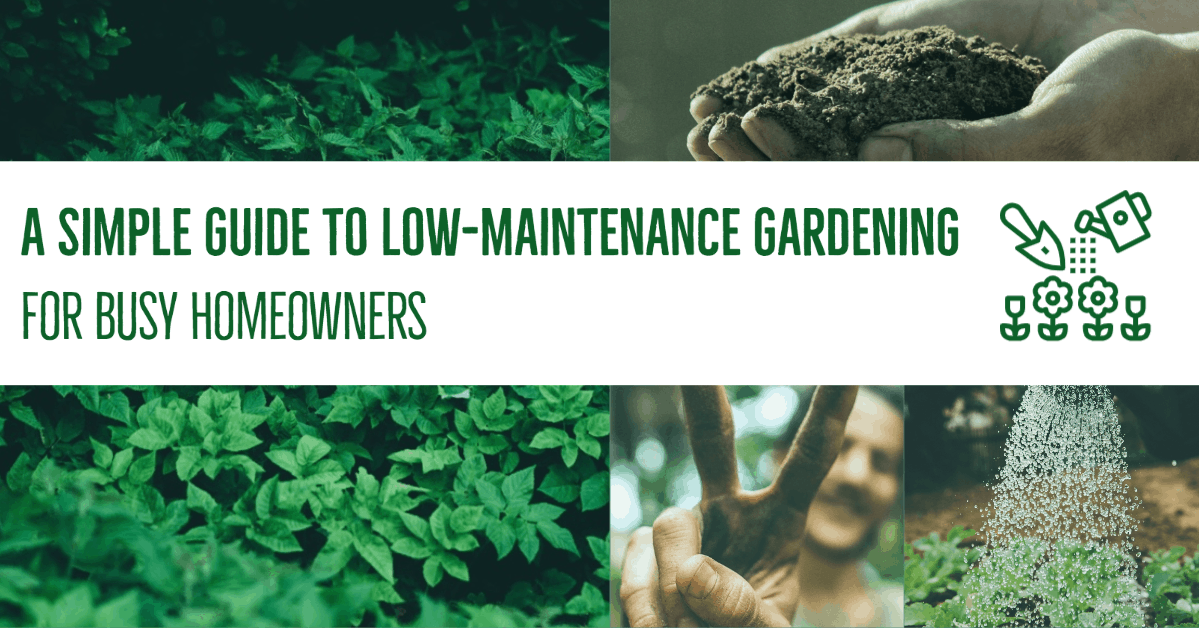You want to boost your home’s curb appeal with a gorgeous garden, but you simply don’t have the time. Who does these days? The amount of maintenance required to keep up with a living, growing garden is just out of reach for so many homeowners. That’s why we’ve compiled this beginner’s guide to low-maintenance gardening. Read on to learn our best tips and tricks for cultivating a beautiful home landscape in very little time.

Want a Low-Maintenance Garden? Choose Low-Maintenance Plants
Seems like a no-brainer until you start looking for just the right seeds or saplings to plant only to find that there are way more to choose from than you could have imagined. Trees, for instance, come in so many shapes and sizes — the maqui reaches only four to five meters (13 to 16 feet) while a spruce can grow to 70 feet. A single tree can weigh 50 tons or more.
So, what are the best low-maintenance plants to grow around your home?
Hostas
Hostas are a perennial favorite for their big two-toned green leaves and easy-going nature. Other than a little watering, they require no special care throughout the summer, and they’re great filler plants for areas that need a little something extra between your flashier flowers and plants. Their fullness will shade out weeds, as well, depriving any weed seeds of the sunlight they need to sprout and multiply.
Boxwood bushes
Slow-growing plants like boxwood bushes are a lazy landscapers dream because so little pruning is required. Many varieties have been bred to be disease-resistant and hardy in colder climates.
Begonias
Gardening experts recommend begonias for beginners because they’re nearly impossible to kill. As long as they’re watered regularly, these bright flowers will last all summer long.
Peonies
Peonies come back year after year, blooming in the same spot for decades. They are also known to be drought- and slug-resistant, and unlike roses, the bushes do not require pruning to thrive and only need to be watered about once per week.
Why Plant in the Ground When You Plant in Pots?
Lazy? Sure. But sloppy? No way! A perhaps slightly more expensive but much simpler way to lay out and set up your garden is with container plants. All you need to do is buy a few containers — pots, baskets, or boxes — in varying sizes, potting soil, and, of course, the plants. Place your potted plants in the garden where they’ll get adequate sun. Just remember to water your container garden several times a week, especially on the hottest days of the summer. Hanging plants add dimension to your garden as well, giving it a more interesting and versatile look. With a container garden, you can worry less about weeds and pests, and because you can move the containers around, you’ll be able to give your plants the ideal balance of shade and sun as needed.
Automate Your Irrigation
Forget dragging the hose around the perimeter of your house. A scheduled irrigation system will water your plants for you; all you need to do is set the timer. Drip irrigation is essentially the low-cost alternative to a sprinkler, and it’s an excellent choice if some of your plants can’t survive with just minimal watering. Drip irrigation systems also use 30 to 50% less water than other methods, and they create a healthier growing environment as smaller portions of water are applied over a longer period of time.
More than 65 million people, 29% of the U.S. population, provide care for a chronically ill, disabled, or aging family member or loved one during any given year, and they spend an average of 20 hours each week as a caretaker. Whether you’re caring for a family member, or you’re a parent with a full-time job, or you’re working and going to school at the same time, we know you’re busy. You may not have all the time in the world to dedicate to your landscaping, and that’s okay. Your yard does not have to suffer. With the tips listed above, you can have your garden and enjoy it, too … on your schedule.


